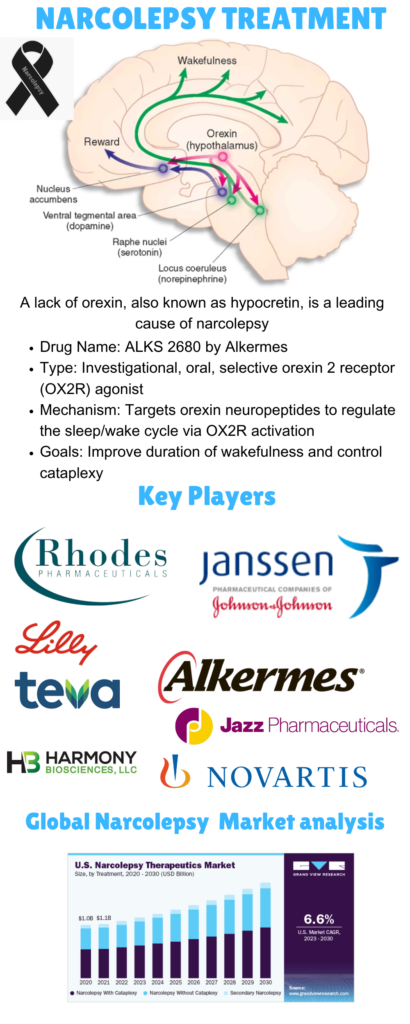Narcolepsy is a central condition that causes people to be too sleepy during the day. Narcolepsy management is symptomatic; currently, there are no disease-modifying treatments available. Many individuals with narcolepsy find that tiredness and cataplexy significantly affect daily living, therefore influencing relationships, school, employment, and social life. Most patients need pharmaceutical treatment, and many find that daytime naps help them to feel more awake.
The goal of narcolepsy treatments is to make people more awake and less likely to have cataplexy attacks, trouble sleeping, sleep paralysis, and dreams that happen during sleep. One of the major goals of ongoing research is to provide a diagnostic tool that can serve as a biomarker for this condition. Medication’s impact on excessive daytime sleepiness (EDS) and cataplexy is connected to how it works, what it targets, and how it affects nerves. For instance, drugs like amphetamines, stimulants, and wake-promoting agents that either make Norepinephrine (NE) and Dopamine (DA) more available or stop them from being taken back up are helpful in controlling EDS. NE and/or 5-HT reuptake inhibition can stop apprehension. Changing the γ-aminobutyric acid receptors (sodium oxybate, baclofen) or histamine H3 receptors (H3Rs) can impact EDS, cataplexy, and other REM dissociative symptoms, such as hypnagogic and hypnopompic hallucinations. Medications that were once used to treat EDS (modafinil, armodafinil, steroids, sodium oxybate) and cataplexy (sodium oxybate, venlafaxine) have been shown to help with these symptoms. FDA has approved seven pharmacological treatments—Xyrem® (sodium oxybate), Provigil® (modafinil), Nuvigil® (amodafonil), methylphenidate, and amphetamine—to treat narcolepsy.

Image Source: Clinical trails and Targets involved in Treatment for Narcolepsy; Key Players and Market Analysis for Narcolepsy Condition
Recently, Alkermes plc has declared starting the Vibrance-2 research, a phase 2 clinical investigation assessing the safety and efficacy of ALKS 2650 against placebo in people with Narcolepsy type 2 (NT2)- Vibrance-2 (NCT06555783). Designed as a once-daily treatment for narcolepsy, ALKS 2680 is the company’s new, experimental, oral, selective orexin 2 receptor (OX2R) agonist under development. A molecule found in the brain, orexin controls the sleep/wake cycle. Because orexin, a neuropeptide generated in the lateral hypothalamus, activates several, downstream wake-promoting paths projecting widely throughout the brain, it is thought to be the master regulator of wakefulness. Whether or not insufficient orexin signaling is the underlying cause of sickness, targeting the orexin system may help to solve extreme daytime sleepiness across hypersomnolence syndromes. ALKS 2680, previously evaluated in a phase 1 study in healthy volunteers and patients with narcolepsy type 1 (NT1), narcolepsy type 2 (NT2) and idiopathic hypersomnia.
The Vibrance Studies investigate how ALKS 2680 given orally once daily might be safe and beneficial for persons 18–70 years of age with either Narcolepsy type 1 (NT1) or Narcolepsy type 2 (NT2) for excessive daytime sleepiness (EDS) symptoms. Those with NT1 might be qualified for the (Vibrance-1(NCT06358950) Study; those with NT2 could be qualified for the Vibrance-2 Study.
For the Vibrance-1 Study, this phase runs six weeks; for the Vibrance-2 Study, it runs eight weeks. Participants will be randomized to take once daily one of three dosages of the study medicine or a placebo. One obligatory in-clinic overnight stay is needed during this period; participants will also complete a maintenance of wakefulness test and a sleep study (polysomnography). Although initially assigned the placebo, this voluntary period lasts seven weeks for the Vibrance-1 research and five weeks for the Vibrance-2 Study and will let all participants get the research medicine.
The study team will monitor participants’ health over the two-week period following subjects stopping the designated study medicine or placebo.
The global market for narcolepsy medicines was worth USD 3.28 billion in 2022, and it’s projected to keep growing at a rate of 7.85% per year from 2023 to 2030.
Dr. Malini Gupta, PhD.
Sources
- https://www.nature.com/articles/nm0207-126
- https://vibrancestudies.com/about-study
- https://www.alkermes.com/research-and-development/pipeline
- https://www.grandviewresearch.com/industry-analysis/narcolepsy-therapeutics-market
- Logos for companies are curated from respective media pages
Disclaimer
The editors take care to share authentic information. In case of any discrepancies please write to newsletter@medness.org
The sponsors do not have any influence on the nature or kind of the news/analysis reported in MedNess. The views and opinions expressed in this article are those of the authors and do not necessarily reflect the official policy or position of MedNess. Examples of analysis performed within this article are only examples. They should not be utilized in real-world analytic products as they are based only on very limited and dated open-source information. Assumptions made within the analysis are not reflective of the position of anyone volunteering or working for MedNess. This blog is strictly for news and information. It does not provide medical advice, diagnosis or treatment nor investment suggestions. This content is not intended to be a substitute for professional medical advice, diagnosis, or treatment. Always seek the advice of your physician or another qualified health provider with any questions you may have regarding a medical condition. Never disregard professional medical advice or delay in seeking it because of something you have read on this website.
MedNess is a part of STEMPeers® which is a 501(c)(3) organization registered in PA as PhD Career Support Group. The organization helps create a growing network of STEM scientists that is involved in peer-to-peer mentoring and support.



